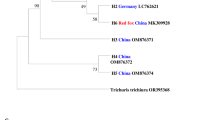Abstract
The dog’s role as a definitive host for a number of zoonotic parasites has been widely studied and recognized as being a significant public health problem worldwide. This study aimed to report, for the first time, our investigation into the role of dogs as a biological transmitter for Ascaris lumbricoides, via necropsy of a sample of rural stray dogs in a developing community in Giza governorate, Egypt, where promiscuous defecation by human was common, and examination for A. lumbricoides worms as well as other ascaridiod nematodes of dogs. The recovered worms were identified in the laboratory after observing cephalic alae and egg morphology under a microscope, as well as scanning electron microscopy of their anterior ends. Of the 25 dogs examined, 14 were infected with Toxocara canis (56.0%), two with Toxascaris leonina (8.0%), and two with A. lumbricoides (8.0%). One dog was co-infected with T. canis and T. l eonina. A. lumbricoides eggs were shown to be viable and 75–80% of eggs embryonated following 3 weeks of incubation at 28°C. The present study suggested that dogs could act as reservoir hosts of A. lumbricoides and environmental contaminators that increase risk of infection in humans.




Similar content being viewed by others
References
Anderson TJC (1995) Ascaris infections in humans from North America: molecular evidence for cross-infection. Parasitol 110:215–219
Anderson TJC (2001) The dangers of using single locus markers in parasite epidemiology: Ascaris as a case study. Trends Parasitol 17:183–188
Ansel M, Thibaut M (1973) Value of the specific distinction between Ascaris lumbricoides Linne 1758 and Ascaris suum Goeze 1782. Int J Parasitol 3:317–319
Crompton DWT (1994) Ascaris lumbricoides. In: Scott ME, Smith G (eds) Parasitic and infectious diseases. Academic, London, pp 175–196
Dutta JK (2002) Disastrous results of indigenous methods of rabies prevention in developing countries. Int J Infect Dis 6:236–237
Joshi BN, Sabne SS (1977) Incidence of Toxocara canis infection in stray dogs in Miraj area. Indian J Pathol Microbiol 20:239–242
Juniper I (1978) Morphology, diet and parasitism in Quebec black bears. Can Field-Nat 92:186–189
Loreille O, Bouchet F (2003) Evolution of ascariasis in humans and pigs: a multi-disciplinary approach. Mem Inst Oswaldo, Rio de Janeiro 98:39–46
Mehlhorn H (ed) (2001) Encyclopedic references of parasitology, vols 1, 2. Springer, Berlin Heidelberg New York
Oshima T (1961) Standardization of techniques for infecting mice with Toxocara canis and observations on the normal migration route. J Parasitol 47:652–656
Raether W, Hänel H (2003) Epidemiology, clinical manifestations and diagnosis of zoonotic cestode infection: an update. Parasitol Res 91:412–438
Rausch R, Tiner JD (1948) Studies on the parasitic helminths of the north central states. Am Midl Nat 39:728–747
Schantz PM (1991) Parasitic zoonoses in perspective. Int J Parasitol 21:161–170
Schantz PM (1994) Of worms, dogs, and human hosts: continuing challenges for veterinarians in prevention of human disease. J Am Vet Med Assoc 204:1023–1028
Seah SK, Hucal G, Law C (1975) Dogs and intestinal parasites: a public health problem. Can Med Assoc J 112:1191–1194
Soulsby EJL (1982) Helminths Arthropods and Protozoa of domesticated animals. Bailliere Tindall, London
Stuart MD, Greenspan LL, Glander KE, Clarke MR (1990) A coprological survey of parasites of wild mantled howling monkeys, Alouatta palliata palliata. J Wildl Dis 26:547–549
Traub RJ, Robertson ID, Irwin P, Mencke N, Thompson RC (2002) The role of dogs in transmission of gastrointestinal parasites in a remote tea-growing community in northeastern India. Am J Trop Med Hyg 67:539–545
Author information
Authors and Affiliations
Corresponding author
Rights and permissions
About this article
Cite this article
Shalaby, H.A., Abdel-Shafy, S. & Derbala, A.A. The role of dogs in transmission of Ascaris lumbricoides for humans. Parasitol Res 106, 1021–1026 (2010). https://doi.org/10.1007/s00436-010-1755-8
Received:
Accepted:
Published:
Issue Date:
DOI: https://doi.org/10.1007/s00436-010-1755-8




